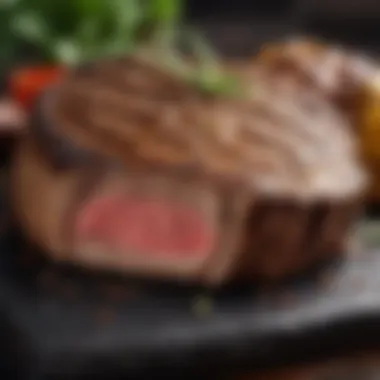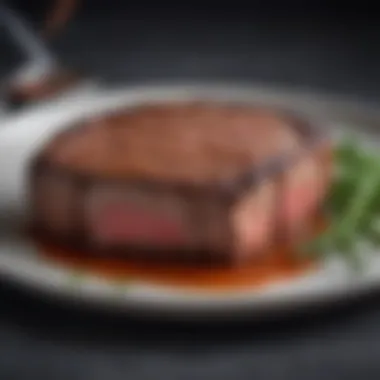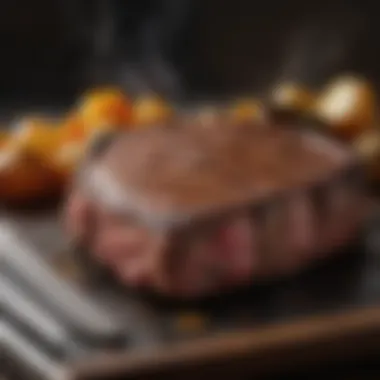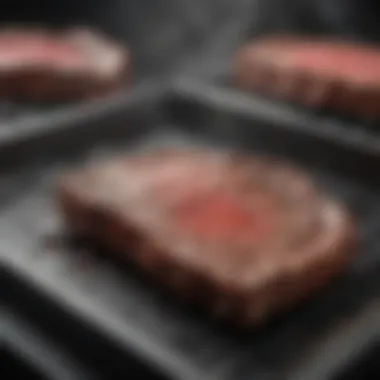How to Cook a Perfect Medium Well Steak


Intro
Cooking steak to the right doneness is an art that balances time, temperature, and technique. For many, a medium-well steak represents the ideal meat experience. This preparation maximizes flavor while ensuring a juicy, yet firmer texture. However, achieving that perfect medium-well doneness requires precision and understanding.
In the sections that follow, we will explore the essential methods for cooking steak to medium-well. From grilling and pan-searing to oven-roasting, each approach has its nuances. We will discuss the importance of temperature control and how resting periods contribute to enhancing flavor. Through this guide, readers will learn practical tips and avoid common mistakes, fostering confidence in their cooking abilities.
Understanding Medium Well Steak
Cooking steak to the desired doneness requires a clear understanding of the various levels of cooking. In this section, we focus on medium well steak, a popular choice among many culinary enthusiasts. Achieving the perfect medium well steak not only enhances the dining experience but also showcases cooking skills. Knowing what to expect from a medium well steak allows cooks to make informed decisions regarding cooking times, techniques, and more.
Defining Medium Well
Medium well is defined primarily by its internal temperature. For steak to reach this doneness, the internal temperature should be between 150°F (about 65°C) and 160°F (approximately 71°C). At this stage, the meat is mostly grayish-brown throughout with a hint of pink in the center. This level of doneness is often desired as it strikes a balance between flavor and texture. While some might define it differently, knowing this benchmark is essential for proper cooking.
Preferred Characteristics of Medium Well
When aiming for medium well, there are some key characteristics to keep in mind:
- Color: The steak should have an overall well-cooked appearance with just a slight blush in the center.
- Juiciness: While medium well does result in less juiciness compared to medium or rare, it should still retain some moisture. Overcooking can lead to dryness.
- Texture: The texture should be firm but not tough, which indicates proper cooking without overshooting the doneness.
Understanding these characteristics can guide cooks in both preparing and assessing their steak. Achieving the ideal medium well steak enhances not only the flavor but also the overall eating experience.
Choosing the Right Cut of Steak
Selecting the right cut of steak is crucial in achieving a perfect medium-well result. The cut not only influences the final flavor and texture but also dictates the cooking time and method. Different cuts have varying levels of tenderness and fat content, which contribute to how they cook and how they should be prepared. When aiming for medium-well steak, understanding your options and their specific characteristics can lead to a more successful cooking experience.
The benefits of choosing the right cut include:
- Flavor development: Certain cuts can enhance the overall taste.
- Cooking efficiency: Some steaks cook faster than others, which can support an optimal medium-well doneness.
- Texture consistency: Choosing a well-marbled cut can improve juiciness and tenderness within the specified doneness.
Popular Cuts For Medium Well Preparation
When cooking steak to a medium-well finish, some cuts are better suited for the job than others. Popular options include:
- Ribeye: Known for its rich marbling, ribeye offers both flavor and tenderness, making it an excellent choice for medium-well cooking.
- Sirloin: With less fat than ribeye, sirloin can still maintain good texture and flavor when cooked to medium-well.
- Filet Mignon: This cut delivers a buttery tenderness, working well when cooked medium-well, provided to monitor carefully to avoid drying out.
- New York Strip: This cut is flavorful and well-marbled, often achieving a good medium-well finish.
These cuts can stand up well to the varying cooking processes but remember that each cut demands different attention.
Factors Affecting Cooking Time by Cut
When cooking steak to a medium-well doneness, various factors influence the cooking time, based on the cut's characteristics:
- Thickness of the Cut: Thicker cuts will require a longer cooking time than thinner ones. A thicker ribeye will take longer to reach the desired internal temperature than a thinner sirloin.
- Fat Content: Cuts with higher fat content, such as ribeye, may have a slightly longer cooking time because the fat renders during the cooking process but adds flavor and moisture.
- Bone Presence: Cuts like T-bone or Porterhouse cook differently due to the bone, which can insulate part of the meat from heat and alter cooking times.
- Starting Temperature: Steaks that are at room temperature or slightly warmer before cooking will cook faster than those taken straight from the refrigerator. Allowing a steak to rest at room temperature for 30 minutes before cooking can help with even cooking.
Cooking Techniques for Medium Well Steak
Cooking techniques play a crucial role in achieving the medium-well doneness of steak. Understanding these methods allows cooks to maximize flavor and texture. Each technique has its specific benefits and considerations, which impact the final result. In the following subsections, we will explore grilling, pan-searing, and oven-roasting, focusing on key characteristics that enhance the cooking process.
Grilling Process
Preheating the Grill


Preheating the grill is essential in achieving a consistent cooking environment. By allowing the grill to reach the desired temperature before placing the steak on it, cooks can ensure even cooking. A well-preheated grill sears the meat, creating a desirable crust that enhances flavor. The main characteristic of preheating is its ability to deliver heat uniformly. This method is a beneficial choice because it also reduces cooking time significantly. However, an overheated grill may lead to burnt surfaces, which can alter the flavor negatively.
Recommended Cooking Time
The recommended cooking time for a medium-well steak typically ranges from 6 to 8 minutes per side, depending on the thickness of the cut. This specific aspect ensures that the internal temperature reaches approximately 150 to 155 degrees Fahrenheit. Following this guideline is crucial for achieving the ideal doneness without the risk of overcooking. The importance of timing cannot be overstated, as it directly affects the final taste and texture. A unique feature of managing cooking time is allowing for slight adjustments based on heat levels or grill types, which can be advantageous for different cooking scenarios.
Checking for Doneness
Checking for doneness is an integral part of the grilling process. The most reliable method involves using a meat thermometer that accurately reads the internal temperature. This technique is preferred because it takes the guesswork out of the cooking process. A common characteristic is ensuring that the steak reaches the correct temperature before removing it from the grill. This practice helps avoid both undercooking and overcooking, contributing directly to the meat's overall quality. The potential disadvantage lies in the need for tools, which might not be accessible to all cooks.
Pan-Searing Methods
Choosing the Right Pan
Choosing the right pan is a vital part of the pan-searing method. A heavy-bottomed skillet, such as cast iron or stainless steel, provides excellent heat retention. This characteristic plays a crucial role in achieving a perfect sear on the steak. The benefit of using a suitable pan is its ability to conduct heat evenly, which results in a nicely browned exterior. However, some pans may require more attention and frequent monitoring to avoid hotspots, which could burn the steak.
Optimal Heat Settings
The optimal heat setting for pan-searing is medium-high. This setting allows the steak to sear properly while cooking evenly. A key aspect of using the right heat level is to create a Maillard reaction, which enhances flavor. This technique is often favored due to its speed and effectiveness in developing a crust. However, temperatures that are too high can lead to quick overcooking or uneven results if not monitored properly.
Cooking Duration
Cooking duration for pan-searing typically ranges between 4 to 6 minutes per side for medium-well. This timeframe is essential to achieve the targeted internal temperature for doneness. The unique feature of managing cooking duration is the ability to obtain a flavorful crust without compromising the inside. Adjustments might be necessary based on steak thickness, which could be both beneficial and challenging for novice cooks.
Oven-Roasting Guidelines
Roasting Time and Temperature
Roasting time and temperature play a significant role when preparing steak in the oven. Typically, an oven should be set to 400 degrees Fahrenheit, with a cooking duration of about 20 to 25 minutes for a medium-well steak. This specific characteristic makes oven-roasting a reliable method. It is advantageous as it allows for consistent heating, leading to even cooking throughout the meat. However, it may not provide the same crust as grilling or pan-searing if proper techniques are not used.
Best Practices for Even Cooking
Best practices for even cooking include placing the steak on a wire rack in the oven and turning it halfway through the cooking time. This ensures that hot air circulates around the meat, cooking it uniformly. The key aspect of this method is maintaining consistency. It improves the overall quality of the steak. The disadvantage, however, could be that it requires more time compared to quicker methods like grilling or pan-searing.
Monitoring Internal Temperature
Monitoring internal temperature while oven-roasting is crucial for achieving perfect doneness. A meat thermometer is again the best tool for this task, ensuring the steak reaches the desired internal temperature. This characteristic reinforces the importance of precision. The advantage of this method is the prevention of overdone steak, aligning with the goal of medium-well cooking. The limitation can be the need for additional tools and the potential complexity it adds to the cooking process.
Timing Considerations
Timing considerations play a crucial role in achieving a perfectly cooked medium-well steak. The dining experience hinges not only on the quality of the cut but also on how you manage the cooking time. Underestimating or overestimating the duration can lead to a less favorable outcome. Therefore, understanding the intricacies of timing can elevate the quality of your meal substantially.
Understanding Steak Thickness
The thickness of the steak is a primary factor in determining the cooking time. Generally, thicker cuts will require more extended cooking periods compared to thinner steaks. A common standard is to measure the thickness at its thickest point. For a medium-well steak, an optimal thickness ranges from one to one-and-a-half inches. This thickness allows for even cooking while reaching the desired internal temperature of approximately 150°F to 160°F.
Calculating Cooking Times
General Guidelines Based on Weight
When determining cooking times, weight serves as a reliable guideline. For instance, a typical one-inch steak weighs around 8 ounces. Based on direct heat and cooking methods like grilling or roasting, cooking times can differ.


- Cooking Time Estimates: For a one-inch steak, a general rule is to cook for about 4 to 5 minutes on each side for medium-well. As weight increases, so do the cooking times. For example, a two-inch steak may require 10 to 12 minutes per side.
This guideline is beneficial because it helps set expectations. The more precise cooking allows for a better dining experience. The downside of using weight as the only metric is that it doesn’t account for factors like heat variability or steak structure.
Adjustments for Different Methodologies
Variations in cooking techniques also necessitate adjustments in cooking times. For example, pan-searing typically cooks steak faster than baking in the oven. When pan-searing, remember to maintain a consistent high heat. A thicker steak may need longer than a thinner cut even if they are the same weight, especially when using different methods.
- Method-Specific Adjustments: When braising or slow-cooking, cooking times can increase significantly. This method usually means cooking at lower temperatures for an extended period, allowing the meat to tenderize adequately.
The critical aspect of these adjustments is that they ensure steaks reach the desired doneness without compromising flavor or texture. However, changes in methodology often require a trial-and-error process to perfect the balance between cook time and method.
"A well-cooked steak is a blend of precision, patience, and practice."
In summary, understanding the timing considerations associated with steak thickness and the calculation of cooking times lays the foundation for grilling, pan-searing, or roasting a medium-well steak. Each of these elements reinforces the importance of a well-timed process to arrive at a satisfying culinary experiences.
Monitoring Temperature for Medium Well
Monitoring the temperature of your steak is crucial when cooking to medium well. This process goes beyond mere routine; it ensures that the meat achieves the desired level of doneness while maintaining its flavor and juiciness. When cooking steak, especially to a specific doneness like medium well, precision becomes pivotal. Undercooking can result in an undesirable texture, while overcooking leads to a tough, dry product.
Proper temperature monitoring helps to capture the perfect moment to remove the steak from heat. It allows for better control over cooking times, promoting culinary confidence and consistency.
Using a Meat Thermometer
A meat thermometer is an essential tool in achieving the correct internal temperature for steak. It provides an accurate reading that cannot be matched by visual cues alone. Choose either an instant-read thermometer for quick checks or a leave-in type for continuous monitoring during cooking.
- Insert Correctly: Insert the thermometer into the thickest part of the steak. Avoid touching bone or fat, as this can lead to inaccurate readings.
- Read Approriately: Wait a few seconds for the reading to stabilize before checking. This will ensure you get an accurate temperature.
- Sterilize After Use: Always clean the thermometer after each use to prevent cross-contamination.
Desired Internal Temperature
For a medium-well steak, the target internal temperature falls between 145°F and 150°F (about 63°C to 66°C). Achieving this temperature will result in a steak that has a warm, pink center without excessive juiciness leaking out.
"Perfectly cooked medium well steak delivers a rich flavor with a satisfying texture."
By ensuring that your steak reaches this precise temperature, you can enjoy a meat dish that is not only flavorful but also safe to eat. Use the following guidelines to help track your cooking:
- Remove from Heat: Take the steak off the heat source when it reaches 140°F. The temperature will continue to rise another 5 to 10 degrees during resting.
- Rest the Steak: Allow the steak to rest for at least 5 minutes before slicing. This helps the juices redistribute throughout the meat.
Accurate temperature control is the foundation of excellent steak preparation. It safeguards against common mistakes, producing the tender and flavorful medium-well experience you expect.
Resting the Steak
Resting a steak is an often overlooked but crucial step in the cooking process. It involves allowing the steak to sit for a certain period after it has been removed from the heat source. This rest period enables the juices within the meat to redistribute, leading to a more flavorful and moist eating experience. Without this, your steak may end up dry, even if cooked to the desired doneness. Understanding the importance of this step can dramatically improve the quality of your steak.
One primary benefit of resting is the increased moisture. When meat cooks, the muscle fibers contract and push juices towards the center. By allowing the steak to rest, these juices have a chance to redistribute throughout the meat. If you cut into a steak immediately after cooking, most of the juices will escape onto the cutting board instead of remaining in the steak. Therefore, it is essential to be patient and let it rest.
There are some specific considerations to keep in mind. The size of the steak significantly influences how long it should rest. A thicker cut may require more time than a thinner one. Additionally, the cooking method plays a role in the effectiveness of resting. Higher cooking temperatures may necessitate a longer resting period.
"Resting meat is not just a suggestion; it is a necessity for better flavor and juiciness."
Why Resting is Important


Resting is important for several reasons. First, it enhances flavor retention. As previously mentioned, the juices redistribute during the resting phase, improving the overall flavor richness. This process is particularly crucial for a medium-well steak, which aims for a moist yet firm texture.
Another point is that resting minimizes the chances of overcooking. If you let the steak sit, it continues to cook slightly, which allows for a perfect internal temperature without going beyond medium-well. This is particularly useful for cuts that can easily go from perfect to overdone.
Finally, resting offers a moment to enhance the dish with complementary elements. During this time, one can prepare sides or sauces, ensuring everything is ready for a well-constructed meal.
Recommended Resting Times
The recommended resting time for a medium-well steak typically ranges from 5 to 10 minutes. Here are some guidelines based on thickness:
- Steaks up to 1 inch thick: 5 minutes
- Steaks 1 to 1.5 inches thick: 7 to 8 minutes
- Steaks over 1.5 inches thick: 10 minutes
It is advisable to tent the steak loosely with foil during the resting period. This helps retain warmth without trapping steam, which can cause the steak to lose its desirable crust.
In summary, while it may feel tempting to cut into a steak right after cooking, taking the time to rest will significantly enhance the quality of your meal. It's a simple yet effective step that reflects the careful preparation of a perfectly cooked medium-well steak.
Common Mistakes to Avoid
Cooking a medium-well steak can be a delicate task. Common mistakes can affect not just the flavor but also the overall enjoyment of the steak. Understanding these pitfalls can lead to a more satisfying culinary experience. Avoiding these errors is cruical for achieving that perfect doneness.
Overcooking the Steak
One of the most frequent errors in steak preparation is overcooking. This often happens when cooks are unsure about the right internal temperature or simply lose track of time. Overcooking transforms a potentially juicy steak into a dry and chewy piece of meat.
To mitigate this, it is essential to use a meat thermometer. Cook the steak until it reaches the desired internal temperature of 150°F (65°C). Another mistake people make is leaving the steak on the heat for too long. This can happen during grilling or pan-searing when high heat is used excessively.
Tips to Avoid Overcooking:
- Use a thermometer to monitor temperature.
- Allow the steak to rest before serving; it continues to cook slightly during this time.
- Set a timer to keep track of cooking duration.
Underestimating the Importance of Equipment
The tools used in steak preparation can not be sidelined. Many home cooks might not realize that having the right equipment can significantly affect cooking outcomes. A high-quality grill or skillet allows for better heat distribution and retention.
If the equipment's temperature spikes or dips, it can lead to uneven cooking, which is particularly problematic when aiming for a specific doneness like medium well.
Key Equipment Considerations:
- Invest in a good meat thermometer for accurate readings.
- Use a cast iron skillet for pan-searing; it holds heat well.
- Ensure the grill is preheated before cooking to avoid sticking and uneven results.
By carefully monitoring these aspects, the chance of common mistakes diminishes significantly, resulting in a steak that is both delicious and properly cooked.
Final Considerations
When it comes to cooking a steak to a medium-well doneness, certain final considerations play a critical role in achieving the desired outcome. Recognizing the importance of quality and enhancement methods cannot be overstated. While knowing cooking time and temperature are essential, the nuances of ingredient selection and flavor addition can significantly affect the final product.
Quality of Ingredients
The foundation of a great steak begins with the quality of the ingredients. Selecting a good cut of meat is vital. Look for steaks that have a good amount of marbling, which refers to the fat interspersed within the muscle. This fat melts during cooking and contributes to flavor and juiciness. Common high-quality cuts for medium-well preparation include Ribeye, New York Strip, and Filet Mignon.
Additionally, consider sourcing your meat from reputable suppliers who share details about their sourcing practices. Grass-fed or organic options often offer superior taste and texture compared to conventionally raised beef. When buying, also check for freshness, which can be determined by color and scent. Fresh meat should have a bright red color and a clean smell.
Enhancing Flavor Without Compromise
Adding flavor to a steak is as important as the cooking method employed. However, the enhancement must respect the meat's qualities. Marinades can introduce intricate flavors, but must be balanced so they do not overpower the dish. A simple marinade of olive oil, garlic, and herbs can suffice, letting the natural taste of the steak shine through.
Alternatively, simple seasoning with salt and pepper before cooking can also be effective. This practice enhances the steak's inherent flavor without masking it. Moreover, consider adding butter and fresh herbs like thyme or rosemary during the last moments of cooking for a rich finish that complements the meat.







